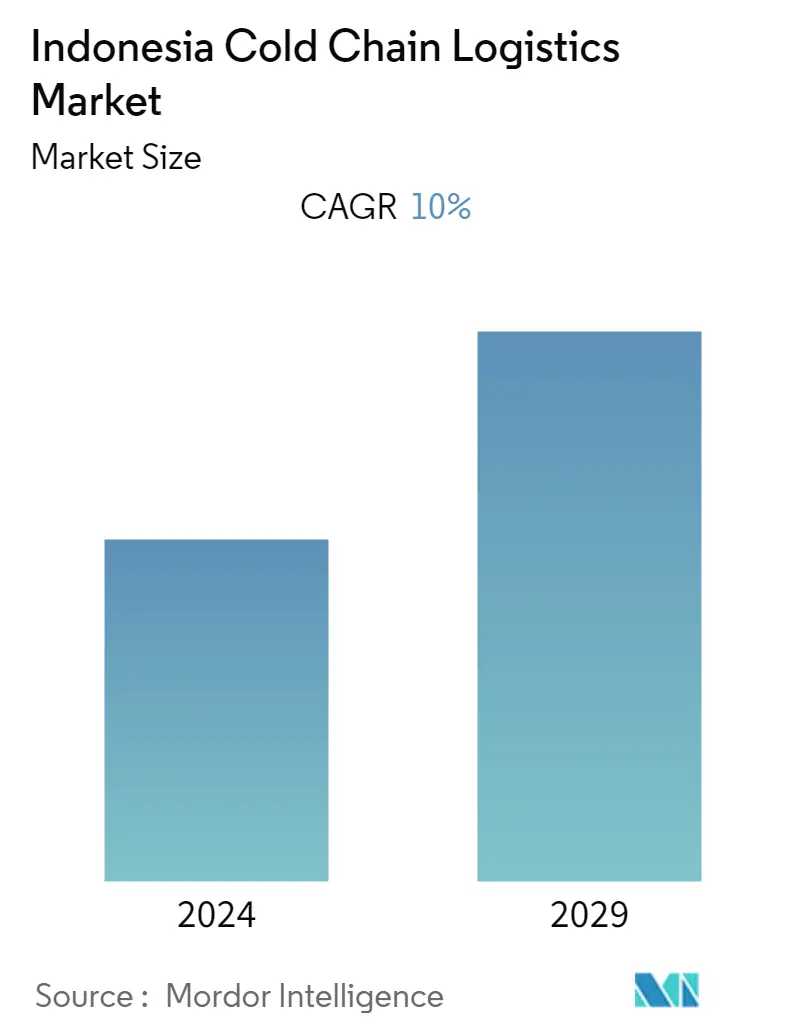Market Size of Indonesia Cold Chain Logistics Industry

| Study Period | 2024 - 2029 |
| Base Year For Estimation | 2023 |
| Forecast Data Period | 2024 - 2029 |
| CAGR | 10.00 % |
| Market Concentration | Low |
Major Players
*Disclaimer: Major Players sorted in no particular order |
Indonesia Cold Chain Logistics Market Analysis
The Indonesian cold chain logistics market is valued at about USD 3.59 billion and is expected to grow at a CAGR of more than 10% during the forecast period.
- Demand for cold storage facilities could be estimated from the consumption of meat, fruits, vegetables, frozen potatoes, fish, shrimp, etc. The main export items in the Indonesian cold chain logistics market are perishable products like frozen food, seafood, and meat. Pharma is another industry that has been instrumental in growing cold chain logistics in Indonesia. As online orders for cool delivery rise and seafood production improves, the number of cold storage installations for the fishing sector is expected to increase quickly in 2023. However, industry players must plan for rising installation costs.
- Greater Jakarta is home to more than 40 cold chain businesses, with North Jakarta, West Jakarta, and Bekasi serving as the primary cold storage hubs. In the nation, there are two different kinds of storage facilities: commercial and industrial. Commercial ones typically have a capacity of less than 500 tonnes and are planned and developed to be rented out or used as the primary facility for business operations like supply chain management and logistics. The industrial storage facilities serve as a component of a production facility and have a capacity of more than 500 tonnes. The absence of electrical power at remote locations is a problem for Indonesia's cold chain business.
- The demand for cold chain logistics has increased in Indonesia as a result of the country's expanding e-commerce sector and growing adoption of digital technology. The country's rising number of refrigerated warehouses will fuel market expansion.
- Additionally, the forecasted growth of the cold chain logistics market in Indonesia is driven by the fast expansion of the processed food industry due to rising food and beverage and meat product consumption.
- A lack of standardization and high operational expenses for cold chain logistics hampers the development of the market in the nation. As a result of the country's burgeoning e-commerce industry, rising levels of digitalization, and ongoing improvements to the nation's delivery infrastructure, there is an increase in the need for cold chain logistics in Indonesia.
- One of the major trends in the Indonesia cold chain logistics industry is the increase in the number of refrigerated warehouses brought on by the country's rising perishables demand.
- The growth of the processed food industry in Indonesia is another factor driving the cold chain logistics market's expansion. The processed food sector is growing quickly as a result of rising demand for frozen fast food items as well as rising consumption of meat and other food and beverage items. Cold storage facilities in Indonesia are leveraging technological advancements to switch to renewable energy sources.
Indonesia Cold Chain Logistics Industry Segmentation
Cold chains are supply chain that specializes in storing, transporting, and preserving cargo that needs to be maintained at a specific temperature or within an acceptable temperature range. It has evolved due to a growing need for temperature-controlled logistics to transport large quantities of food over great distances safely.
The Indonesia cold chain logistics market is segmented by service (storage, transportation, and value-added services (blast freezing, labeling, inventory management, etc.)), by temperature type (chilled, frozen, and ambient), and by application (horticulture (fresh fruits & vegetables), dairy products (milk, butter, cheese, ice cream, etc.), fish, meat, and poultry, processed food products, pharma and life sciences, other applications (chemicals, bakery product, etc.)). The report also covers the impact of COVID-19 on the market. The report offers market size and forecasts for the Indonesian cold chain logistics market in value (USD billion) for all the above segments.
| By Service | |
| Storage | |
| Transportation | |
| Value-added Services (Blast Freezing, Labeling, Inventory Management, etc.) |
| By Temperature | |
| Chilled | |
| Frozen | |
| Ambient |
| By Application | |
| Horticulture (Fresh Fruits & Vegetables) | |
| Dairy Products (Milk, Butter, Cheese, Ice Cream, etc.) | |
| Fish, Meat, and Poultry | |
| Processed Food Products | |
| Pharma and Life Sciences | |
| Other Applications (Chemicals, Bakery Product, etc.) |
Indonesia Cold Chain Logistics Market Size Summary
The Indonesian cold chain logistics market is experiencing significant growth, driven by the increasing demand for cold storage facilities due to the consumption of perishable goods such as meat, fruits, vegetables, and seafood. The market is further bolstered by the expanding e-commerce sector and the rising adoption of digital technologies, which have led to a surge in online orders for cool deliveries. The processed food industry, particularly the demand for frozen fast food and meat products, is also contributing to the market's expansion. However, challenges such as high operational costs and a lack of standardization continue to impede market development. The Greater Jakarta area serves as a hub for cold chain businesses, with both commercial and industrial storage facilities catering to the growing needs of the supply chain and logistics sectors.
Technological advancements, including automation and renewable energy integration, are revolutionizing the cold storage industry in Indonesia, enhancing efficiency and reducing waste. The market is characterized by a fragmented landscape with both local and international players, such as Kiat Ananda Group and GAC Samudera Logistics, actively participating in the sector. Investments in cold chain solutions, like those by Coldspace and Fresh Factory, are aimed at expanding infrastructure and improving operational capabilities across the archipelago. The government's ambitious goals in the fisheries sector, coupled with the increasing demand for high-quality processed foods, are expected to further drive the growth of the cold chain logistics market in Indonesia.
Indonesia Cold Chain Logistics Market Market Size - Table of Contents
-
1. MARKET INSIGHTS
-
1.1 Current Market Scenario
-
1.2 Government Regulations and Initiative
-
1.3 Technological Trends and Automation in Cold Storage facilities
-
1.4 Impact of Emission Standards and Regulations in the Cold Chain Industry
-
1.5 Insights into Refrigerants and Packaging Materials Used in Refrigerated Warehouses
-
1.6 Insights into Halal Standards and Certifications in Indonesia
-
1.7 Impact of COVID-19 on Indonesia Cold Chain Logistics Market
-
-
2. MARKET SEGMENTATION
-
2.1 By Service
-
2.1.1 Storage
-
2.1.2 Transportation
-
2.1.3 Value-added Services (Blast Freezing, Labeling, Inventory Management, etc.)
-
-
2.2 By Temperature
-
2.2.1 Chilled
-
2.2.2 Frozen
-
2.2.3 Ambient
-
-
2.3 By Application
-
2.3.1 Horticulture (Fresh Fruits & Vegetables)
-
2.3.2 Dairy Products (Milk, Butter, Cheese, Ice Cream, etc.)
-
2.3.3 Fish, Meat, and Poultry
-
2.3.4 Processed Food Products
-
2.3.5 Pharma and Life Sciences
-
2.3.6 Other Applications (Chemicals, Bakery Product, etc.)
-
-
Indonesia Cold Chain Logistics Market Market Size FAQs
What is the current Indonesia Cold Chain Logistics Market size?
The Indonesia Cold Chain Logistics Market is projected to register a CAGR of 10% during the forecast period (2024-2029)
Who are the key players in Indonesia Cold Chain Logistics Market ?
Kiat Ananda Group, Pluit Cold Storage PT., Enseval Putra Megatrading Tbk, PT, MGM Bosco Logistics Bekasi and GAC Samudera Logistics are the major companies operating in the Indonesia Cold Chain Logistics Market .

